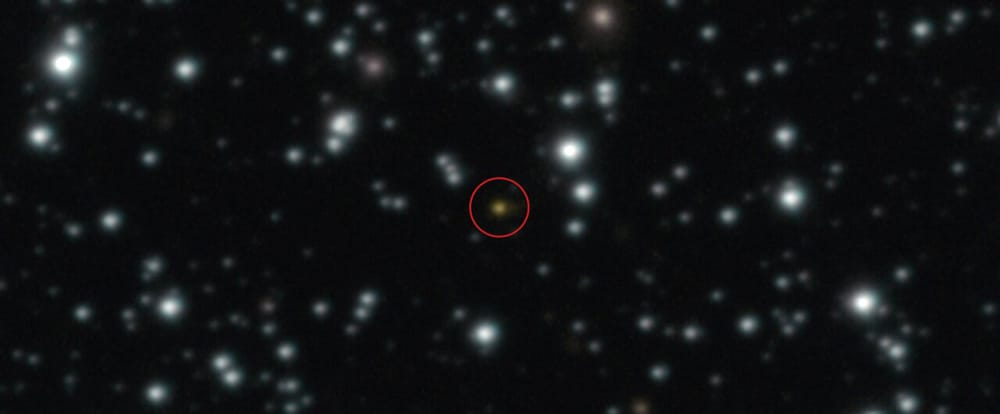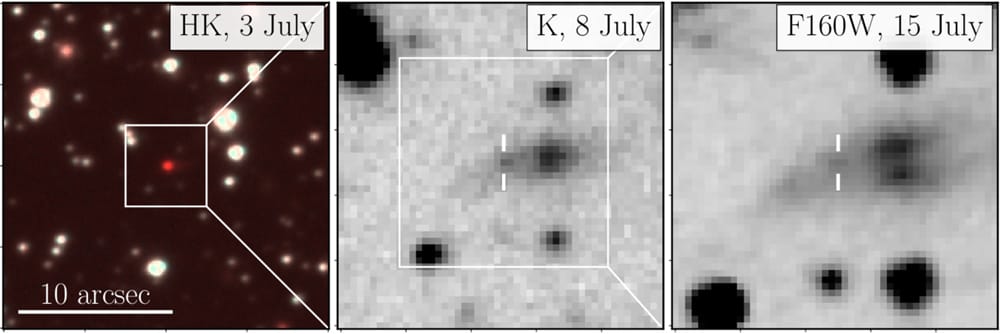- Bad Astronomy Newsletter
- Posts
- A white dwarf may have been torn to shreds by a black hole
A white dwarf may have been torn to shreds by a black hole
Just writing that sentence made the hairs on the back of my neck stand up

The Trifid Nebula and environs. Credit: RubinObs/NOIRLab/SLAC/NSF/DOE/AURA
October 9, 2025 Issue #942
A very unusual gamma-ray burst may be from a dead star torn apart by a black hole
All GRBs are weird, but some are weirder than others
On July 2, 2025, NASA’s orbiting Fermi observatory detected a flash of extremely high-energy gamma rays coming from the constellation of Aquila. That’s not so unusual; flashes similar to this occur literally every day.
But then something extremely weird happened: the object flashed again. That’s unexpected; gamma-ray bursts (or GRBs) occur when a black hole is born, either when a very massive star explodes, or two ultra-compact neutron stars collide. Either way, the progenitor object is gone, destroyed in the mind-vaporizingly immense explosion. How could something that’s blown to bits and collapsed into a black hole send out another huge wave of gamma rays?
Then it got even worse: a few hours later it did it again. Fermi detected a third blast of gamma rays from this same object! What the WHAT?

The GRB 250702B (circled) as seen by the Very Large telescope just days after the explosion. Credit: ESO/A. Levan, A. Martin-Carrillo et al.
The object was named GRB 250702B (the second GRB seen that day, and in fact the other two flashes from it were designated D and E). It was seen in the direction of the constellation of Aquila, the eagle. That in itself was interesting: essentially all GRBs occur in galaxies very far away from us, usually billions of light-years away. But Aquila lies in the plane of the Milky Way, along the disk of our own galaxy, implying whatever this object is it’s close by, inside our galaxy.
But that idea was dashed when follow-up observations of it were taken with the Very Large Telescope. GRBs typically have an afterglow, visible light from the explosion that can take days to fade. GRB 250702B’s afterglow was detected, but it was next to a faint extended source, and even inside it. More observations taken with Hubble definitely showed that was a galaxy, making it pretty clear this GRB was indeed extragalactic.
So how could it burst three times?
Astronomers have an idea, and it’s weird (as it would have to be). This wasn’t the usual kind of GRB that creates a black hole. Instead, it may have been a white dwarf that was torn apart by a black hole [link to journal paper].
That’s…terrifying. A white dwarf is a super-dense object left over when a star like the Sun dies. The core of the star compresses as the outer layers blow off; what remains is something the size of Earth but with a mass of a star. A cubic centimeter of this white dwarf weighs a ton. The gravity on the surface is extremely strong, a hundred thousand times stronger than Earth’s. Tearing one apart takes a lot of strength. A lot a lot.
Which is where a black hole comes in. It has a much fiercer gravity than even a white dwarf, and if one of those dead stars gets too close, yeah, it could get ripped to shreds. The resulting explosion would be impressive indeed.

Three images of the GRB. Left: two-color infrared image from the VLT. Middle: Another infrared image showing it’s sitting in some fuzz. Right: a Hubble image showing the fuzz is a galaxy, and the GRB is inside it. Credit: Levan et al. 2025
But why think this is what happened here? Because of the weirdest part of all this. The second blast of gamma rays from GRB 250702B occurred 2,825 seconds after the first. The third one, though, happened 11,304 seconds after the second. That’s almost exactly 4 x 2,825 (it’s just four seconds off).
When astronomers see a signal repeating on a regular interval, they thing rotation or revolution: something spinning or something in orbit. A hot spot on a star, for example, will make it brighten every time that spot rotates into our view. Or, an object orbiting something else might emit energy whenever it passes close to the object it’s orbiting.
For GRB 250702B, what they think might have happened is a white dwarf got too close to a black hole. On the first pass it had some material torn off, which causes a bright flash. Same thing on the second pass. For some reason (as yet unknown) it didn’t do anything (or the flashes were hidden somehow) on the third and fourth passes, but then on the fifth the star was ripped apart, destroyed by the black hole. The last flash was twice as bright as the first two, and it makes sense it would be the most powerful.

Subscribe to Premium to read the rest.
Become a paying subscriber of Premium to get access to this post and other subscriber-only content.
Already a paying subscriber? Sign In.
A subscription gets you:
- • Three (3!) issues per week, not just one
- • Full access to the BAN archives
- • Leave comment on articles (ask questions, talk to other subscribers, etc.)

Reply